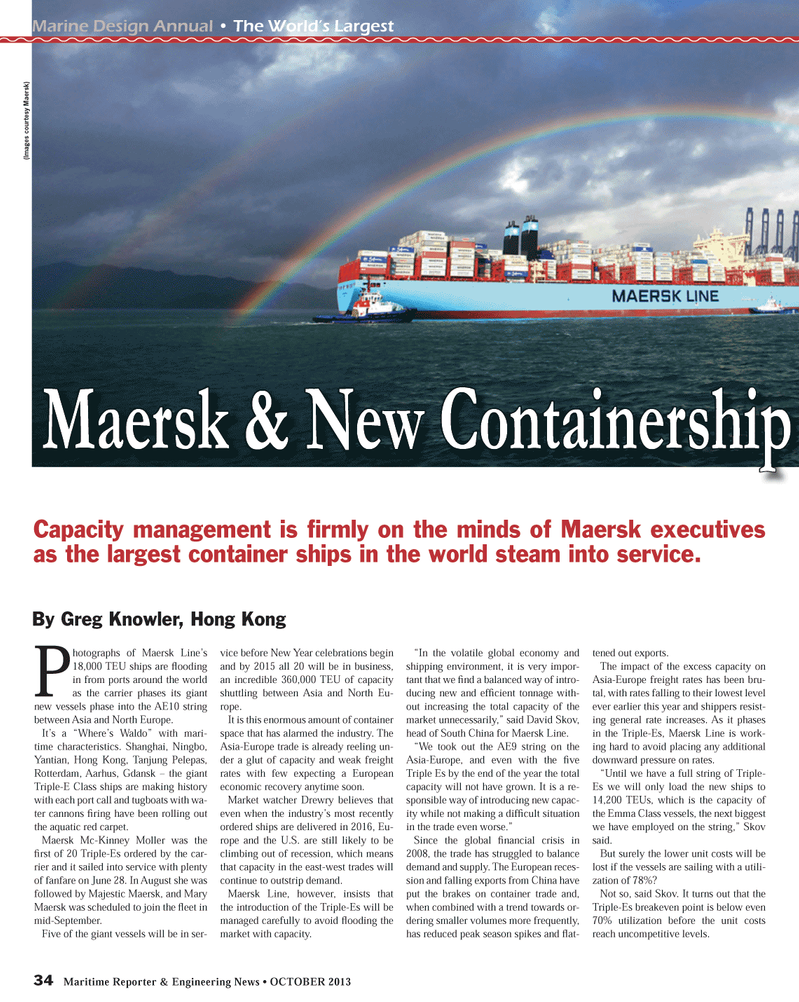
Page 34: of Maritime Reporter Magazine (October 2013)
Marine Design & Construction
Read this page in Pdf, Flash or Html5 edition of October 2013 Maritime Reporter Magazine
34 Maritime Reporter & Engineering News ? OCTOBER 2013 Photographs of Maersk Line?s 18,000 TEU ships are ß ooding in from ports around the world as the carrier phases its giant new vessels phase into the AE10 string between Asia and North Europe. It?s a ?Where?s Waldo? with mari- time characteristics. Shanghai, Ningbo, Yantian, Hong Kong, Tanjung Pelepas, Rotterdam, Aarhus, Gdansk ? the giant Triple-E Class ships are making history with each port call and tugboats with wa-ter cannons Þ ring have been rolling out the aquatic red carpet.Maersk Mc-Kinney Moller was the Þ rst of 20 Triple-Es ordered by the car- rier and it sailed into service with plenty of fanfare on June 28. In August she was followed by Majestic Maersk, and Mary Maersk was scheduled to join the ß eet in mid-September. Five of the giant vessels will be in ser- vice before New Year celebrations begin and by 2015 all 20 will be in business, an incredible 360,000 TEU of capacity shuttling between Asia and North Eu- rope.It is this enormous amount of container space that has alarmed the industry. The Asia-Europe trade is already reeling un-der a glut of capacity and weak freight rates with few expecting a European economic recovery anytime soon.Market watcher Drewry believes that even when the industry?s most recently ordered ships are delivered in 2016, Eu-rope and the U.S. are still likely to be climbing out of recession, which means that capacity in the east-west trades will continue to outstrip demand.Maersk Line, however, insists that the introduction of the Triple-Es will be managed carefully to avoid ß ooding the market with capacity. ?In the volatile global economy and shipping environment, it is very impor- tant that we Þ nd a balanced way of intro- ducing new and efÞ cient tonnage with- out increasing the total capacity of the market unnecessarily,? said David Skov, head of South China for Maersk Line.?We took out the AE9 string on the Asia-Europe, and even with the Þ ve Triple Es by the end of the year the total capacity will not have grown. It is a re-sponsible way of introducing new capac-ity while not making a difÞ cult situation in the trade even worse.?Since the global Þ nancial crisis in 2008, the trade has struggled to balance demand and supply. The European reces- sion and falling exports from China have put the brakes on container trade and, when combined with a trend towards or- dering smaller volumes more frequently, has reduced peak season spikes and ß at-tened out exports.The impact of the excess capacity on Asia-Europe freight rates has been bru-tal, with rates falling to their lowest level ever earlier this year and shippers resist-ing general rate increases. As it phases in the Triple-Es, Maersk Line is work- ing hard to avoid placing any additional downward pressure on rates.?Until we have a full string of Triple- Es we will only load the new ships to 14,200 TEUs, which is the capacity of the Emma Class vessels, the next biggest we have employed on the string,? Skov said.But surely the lower unit costs will be lost if the vessels are sailing with a utili-zation of 78%? Not so, said Skov. It turns out that the Triple-Es breakeven point is below even 70% utilization before the unit costs reach uncompetitive levels.Marine Design Annual ? The World?s LargestMaersk & New Containership Economics ?101? Maersk & New Containership E Capacity management is Þ rmly on the minds of Maersk executives as the largest container ships in the world steam into service. (Images courtesy Maersk) By Greg Knowler, Hong Kong MR #10 (34-41).indd 34MR #10 (34-41).indd 3410/2/2013 4:18:02 PM10/2/2013 4:18:02 PM

 33
33

 35
35
